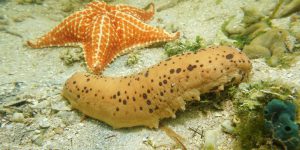Both on land and underwater, many species possess specialized adaptations to either blend in with their surroundings and/or deter predation. Common examples of this include counter-shading of marine fish and mammals (dark coloration on the top of the body, light on the underside), mimicry in octopi, to concealing coloration observed in several species of owls. In recognition of April Fool’s Day in 2021, we are going to look a little more closely at two marine invertebrates with some “foolish”, but incredible, adaptations.
Sea Cucumber
Related to sand dollars and sea urchins, sea cucumbers look like sausages underwater and have no external arms or spines. Sea cucumbers’ common names comes from the physical characteristics of what their body shape and size resemble. These creatures move along the bottom of the ocean by using their podia, which are little feet with suction disks whose size and shape are different depending on the particular species. Sea cucumbers have created neat ways to fool potential predators. When irritated or under threat, the sea cucumber expels its internal organs out through its anus, to confuse and distract predators. Sea cucumbers regenerate these parts in a matter of three to four weeks on average (Vandenspiegel et al. 2000).

Sea Slugs (and Sea Hares)
More recently in the scientific community, news spread that a sea slug (Elysia marginata) cut off its own head, and within a period of weeks, the head regenerated a body. This process is known as autotomy, or the voluntary shedding of a body part (Emberts et al. 2019). We see similar phenomena in lizards, crabs, octopuses, sea stars, amphibians, and even bugs. However, in those cases, the organisms are shedding a tail or other body part, not their head. The sea slug observation was reported by Japanese ecologist Sayaka Mitoh of the Nara Women’s University. The scientist thought that the slug would soon die without its vital organs, but it surprisingly not only survived, but re-grew its body (Mitoh & Yusa 2021). The cut-off body did not regenerate a new head. Autotomy was observed in both wild collected as well as lab-reared slugs. It is possible that the slugs autotomized to either get rid of parasites, or to escape predation. This is incredibly interesting, given that sea slugs themselves are usually around 1 or 2 cm at their largest size. Either way, this adaptation is a fascinating look at how different creatures have evolved to deal with stressors.

How would our world be different if human beings had these same adaptations? We can only imagine…
References:
Emberts, Z., Escalante, I., Bateman, P. 2019. The ecology and evolution of autotomy. Biological Reviews, 94, pp. 1881-1896.
Mitoh, S., Yusa, Y. 2021. Extreme autotomy and whole-body regeneration in photosynthetic sea slugs. Current Biology, 31, pp. R215-R240.
 3
3
